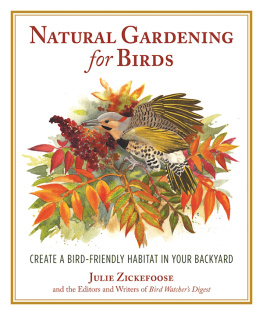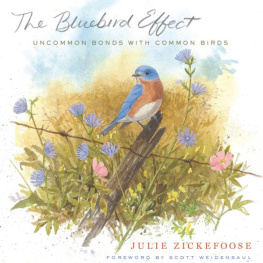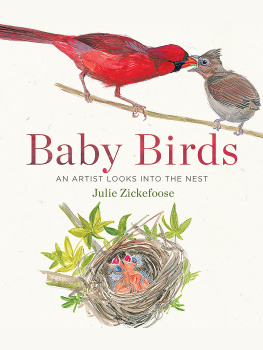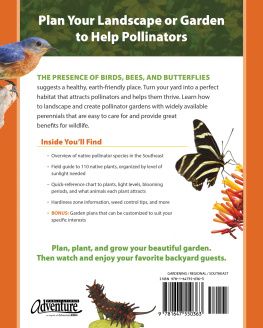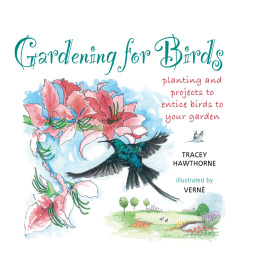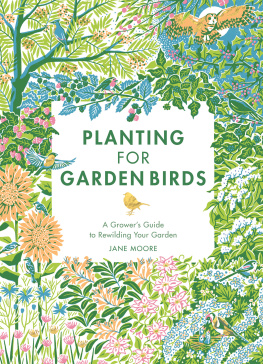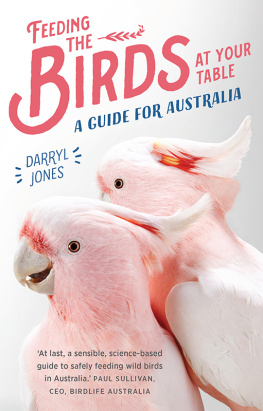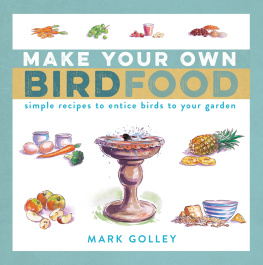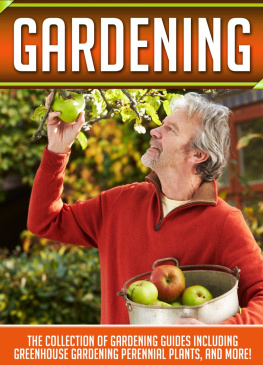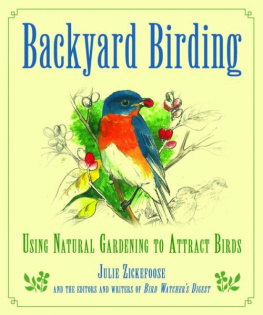For DOD, who always said
Id forget about chasing birds when
I discovered horticulture. You were
rightnow I let them come to me!
Copyright 2001 by Bird Watchers Digest
Illustrations copyright 2001 by Julie Zickefoose
Published by arrangement with Rodale, Inc.
First Skyhorse Publishing edition 2011.
Second Skyhorse Publishing edition 2016.
All rights reserved. No part of this book may be reproduced in any manner without the express written consent of the publisher, except in the case of brief excerpts in critical reviews or articles. All inquiries should be addressed to Skyhorse Publishing, 307 West 36th Street, 11th Floor, New York, NY 10018.
Skyhorse Publishing books may be purchased in bulk at special discounts for sales promotion, corporate gifts, fund-raising, or educational purposes. Special editions can also be created to specifications. For details, contact the Special Sales Department, Skyhorse Publishing, 307 West 36th Street, 11th Floor, New York, NY 10018 or .
Skyhorse and Skyhorse Publishing are registered trademarks of Skyhorse Publishing, Inc., a Delaware corporation.
Visit our website at www.skyhorsepublishing.com.
10 9 8 7 6 5 4 3 2 1
Library of Congress Cataloging-in-Publication Data is available on file.
Cover design by Jane Sheppard
Cover photo illustration by Julie Zickefoose
Print ISBN: 978-1-5107-0247-9
Ebook ISBN: 978-1-5107-0365-0
Printed in China
Contents
Foreword
As our human population grows and large, unspoiled expanses of natural habitat are diminished, its vital that we consider the well being of the birds and wildlife around us. Its little wonder that the creatures many of us grew up with: bluebirds and box turtles, thrashers and monarchsno longer make cameos in our lives. The answer lies with us. Even in our own backyards, we can provide viable habitat options for these and many other wild creatures if we provide them with the four basic elements they require: food, water, a place to nest/reproduce, and a place to roost or rest.
For the past two and a half decades Ive been privileged to watch a master at work in providing for birds and wildlife. Julie Zickefoose has been tuned-in to the natural world her entire life and her years of immersion in nature, combined with a highly evolved nurturing instinct, have made her an expert at creating suitable habitat for wild creatures. Possessing one of North Americas greenest thumbs, Julie maintains gardens that are both lovely and magnetically attractive to birds, butterflies, and the entire guild of pollinators. The ridge-top farm weve shared in southeastern Ohio has been Julies canvas and she has decorated it in extraordinary fashion with birches and maples, salvias and fuchsias, goldenrods and cardinalflower. The diversity of living things that surround us and that visit our home habitat exceeds perhaps every other similar plot of land in our region: 194 bird species and 75 butterflies have been recorded. Seventy-three bird species have been seen at the recirculating bath that Julie keeps freshly scrubbed all summer long. As many as a dozen species of wood warblers breed in the surrounding meadows and woods, dodging the screech and barred owls and sharp-shinned hawks that also find refuge here.
Much of the content in this book was created by a team of gardening columnists, writing for my magazine, Bird Watchers Digest . Julie has contributed a healthy helping of her own material, insight, and advice. Weve updated the lists of recommended plants to match our current knowledge of the best native species for birds and wildlife. The result is a book that is relaxing and enjoyable to read, but with sufficient resource material to serve you as a gardening reference for years to come.
With best wishes for happy birding and gardening,
Bill Thompson III
Publisher, Bird Watchers Digest
Plant It, and They Will Come
A weekend in May, and I find myself in Chicago. Its high migration time, and as I explore the city on foot and by bus, I find warblers everywhere, sitting dazed and confused on the hard sidewalks of the concrete canyons. Other people dont seem to notice this phenomenon; they step over the tiny birds as they would candy wrappers, but Im scurrying everywhere, trying to help. These avian migrants have arrived here at night, having been drawn in by the skyscrapers lights. Theyve bumbled about in confusion, and daylight has found them in unfriendly territory. I see a tiny yellowthroat being blown about in the backdraft of a city bus, and I pick it up; its exhausted but unhurt, its eyes bright and defiant in its black bandit mask. Smiling, I slip the little bird into a coat pocket. Ive got a plan.
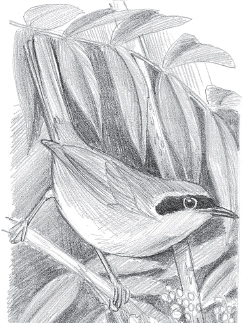

T HE M AGIC H EDGE
Theres a park on a little peninsula that juts out into Lake Michigan, and in that park is a row of bushes thats called the Magic Hedge. Bird watchers have given it this name because any species is likely to turn up in it at any time. Its nothing special botanically, mostly privet, but its the last real cover migrant birds can use to feed and rest before they make the great flight across Lake Michigan on their way north in the spring. In the fall, exhausted migrants plummet into the hedge after theyve flown the length of the lake on their way south. The hedge is essential, and it doubtless saves many small lives. I would hate to be a caterpillar in the Magic Hedge.
I disembark the bus and make my way to the lakefront and the hedge. I barely get my pocket open before the little yellowthroat slips out and dives into the hedge; hell make it now. Glowing with satisfaction, I scan the privet bushes with my binoculars and see the first sedge wren of my life, as if in reward for the small service Ive done. Other birders stand quietly, appreciating wave after wave of birds that pass through the hedge.
The Magic Hedge quietly gives its gift to birds and birders alike every season. I reflect on the interrelationship of this simple planting, intended merely as a windscreen, and the hordes of migrant birds and bird watchers who have learned to exploit it. Yes, its importance is enhanced by its unique location, but there are Magic Hedges everywhere. Weve only to plant them or to stand back and let them develop.

B IRDS : N ATURAL G ARDENERS
When my husband and I bought our 80-acre, southeast Ohio property in 1992, the grounds were devoid of trees, shrubs, or flowers. The big meadow, mown three times each summer, was mostly orchard grass and not very botanically interesting.
In the 23 years since then, weve done a dance with the property, planting here, mowing there, letting this and that go. Weve planted butterfly gardens, hummingbird gardens, and seed gardens for the finches. Our efforts, while colorful and pleasing, pale in comparison to the intricate tapestry nature has woven around the edges of our lawn. Birds like edges; they perch a lot where woodland meets meadow, and they naturally sow the seeds of the fruits they enjoy there. Black raspberry, sumac, dogwood, sassafras, tupelo, aster, goldenrod, foxtail, deertongue, spicebushits a glorious tangle, one we could never dream of or plant ourselves.

